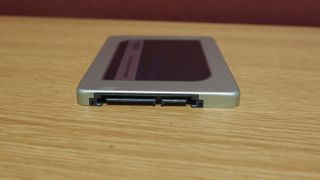TechRadar Verdict
If you’re looking for a large capacity solid state drive that doesn’t break the bank, then the Crucial MX300 1050GB is definitely worth considering, offering plenty of features and decent performance.
Pros
- +
High capacity
- +
Good price
- +
Decent performance
- +
Plenty of features
Cons
- -
Still expensive
- -
Not the fastest SSD
- -
SATA 3 connection showing its age
Why you can trust TechRadar
Usually when you want to take advantage of the speeds that solid state drives provide you have to make a compromise when it comes to storage space, as SSDs usually come in smaller capacities than regular hard drives.
Thankfully there are an increasing number of high capacity SSDs being released, such as the Crucial MX300, which we review here. This drive is available in 525GB, 750GB, 1050GB and 2TB capacities (we’ve got the 1050GB version in for review), which means if you want a fast SSD to act not only as a boot drive for your operating system, but also to store your files and folders, you can have the best of both worlds.
Price is still an issue when you go for large capacity SSDs, with the price per GB being a lot higher than standard hard drives. However, prices of SSDs are dropping, though there are occasional NAND shortages that can up the prices, and hopefully we’ll continue to see price drops in the future. At £229 ($249, around AU$390), this isn’t too high of a price for 1TB of SSD storage compared to its competitors, though it’s still a high price tag compared to traditional hard drives of that capacity.

The first thing that may jump out at you when you consider buying the Crucial MX300 SSD 1050GB is that the ‘1050GB’ capacity seems like an odd amount when most hard drive manufacturers would round up to 1TB.
The fact that Crucial is making a fuss over the additional 50GB is clear when you factor in that a 1TB hard drive doesn’t offer 1000GB of storage dude to conflicting decimal and binary measurements of storage space. While many hard drive manufacturers list a gigabyte (GB) as 1,000,000,000 bytes (a decimal measurement), many systems define a gigabyte as 1,073,741,824 bytes, therefore a 1TB drive can only hold 931GB of data. Therefore when you plug in an empty drive you’ll see less capacity than advertised even without any files saved to the drive. Suddenly, that extra 50GB seems more relevant, giving you closer to true 1TB capacity than some of its rivals.
The Crucial MX300 SSD uses the Marvell 88SS1074 4-channel controller and Micron 384-bit TLC NAND. According to Crucial the drive is capable of sequential 530MB/s read, 520MB/s write speeds. The MX300 also comes with TRIM support, Self-Monitoring and Reporting Technology (S.M.A.R.T), Device Sleep Support features and 256-bit encryption support.
A three-year warranty for up to 360TB of data written to the drive is included, along with Acronis True Image software for backing up or migrating your data to the drive. Overall, this is a large capacity SSD that promises very good performance and comes with tools and features that we’ve come to expect of SSDs and hard drives in general.

Performance
In our benchmark tests the Crucial MX300 1050GB SSD stuck close to the speeds Crucial were promising, with the Crystal Disk benchmark showing sequential read speeds of 534.1MB/s and write speeds of 517.4MB/s.
This puts it at slower for read speeds than the Adata SSD Ultimate SU800, which scored 562MB/s in the same benchmark. However, it was faster at writing data, with the SU800 only managing 507.6MB/s.
The ATTO benchmarks showed similar results, with 533MB/s read and 515MB/s write. This means the Crucial MX300 1050GB SSD isn’t the fastest SSD on the market (especially compared to M2 SSDs that don’t rely on the aging SATA 3 connection, such as the Toshiba OCZ RD400 512GB SSD), but nor is it the slowest.
Its performance in our tests means this should be a drive that’s fast enough for most people who want an affordable high-capacity solid state hard drive. However if you’re looking for more speed then you’re going to have to spend more money and possibly even take a hit on capacity as well.

Matt is TechRadar's Managing Editor for Core Tech, looking after computing and mobile technology. Having written for a number of publications such as PC Plus, PC Format, T3 and Linux Format, there's no aspect of technology that Matt isn't passionate about, especially computing and PC gaming. Ever since he got an Amiga A500+ for Christmas in 1991, he's loved using (and playing on) computers, and will talk endlessly about how The Secret of Monkey Island is the best game ever made.

